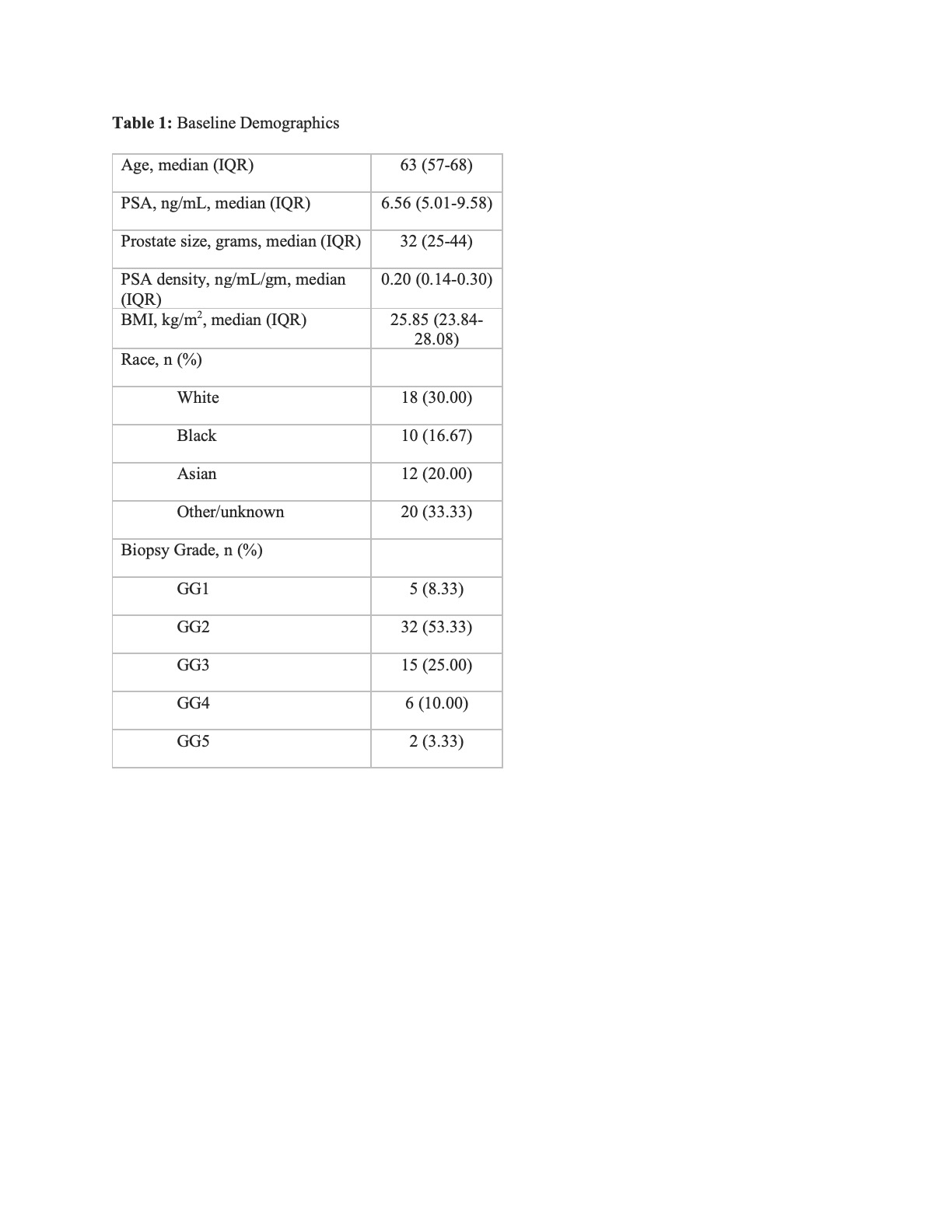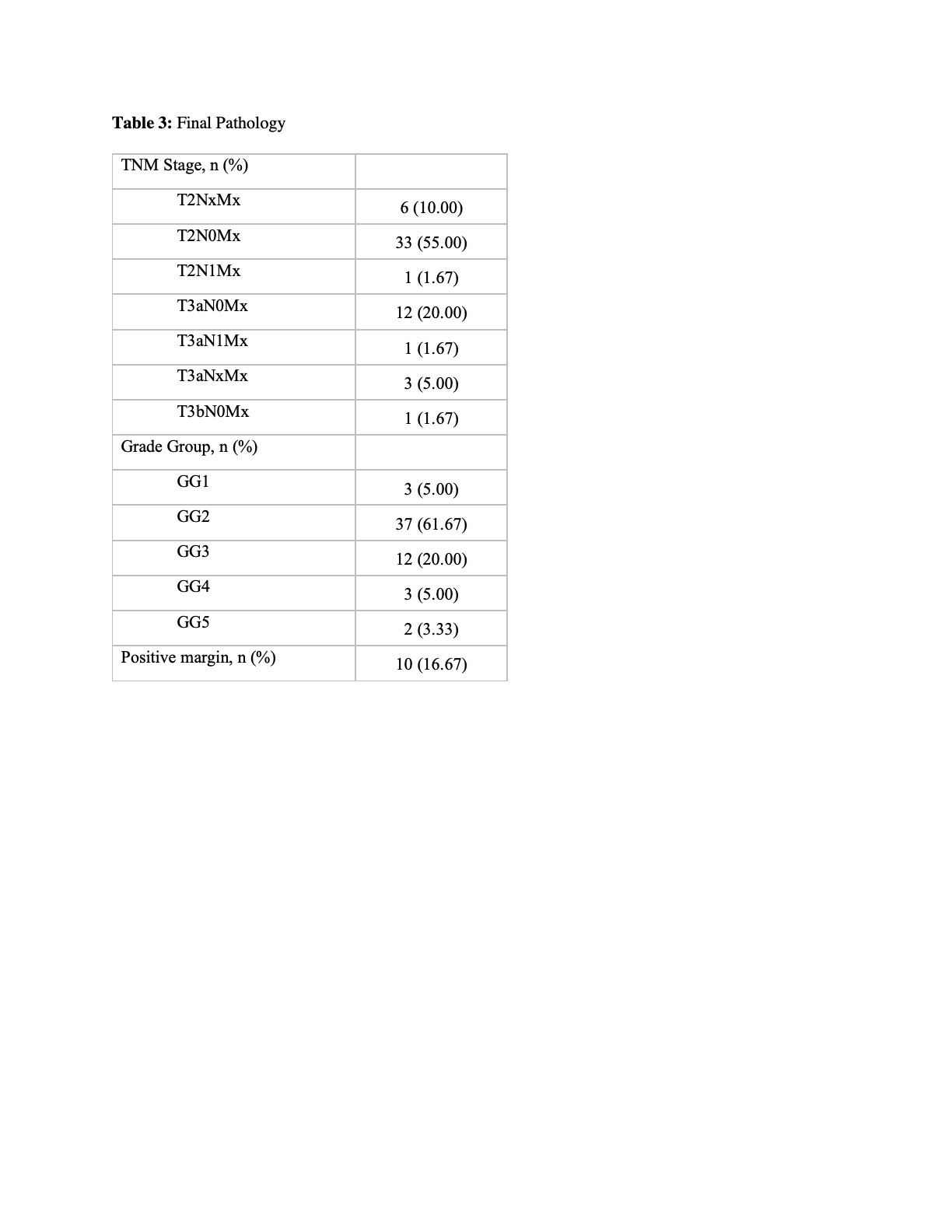Back
Poster, Podium & Video Sessions
Video
V07: Prostate, Penile, Testis & Misc. Oncology I
V07-02: Single Port Robotic Assisted Laparoscopic Radical Prostatectomy: Initial Experience and Technique at Northwell Health
Sunday, May 15, 2022
7:10 AM – 7:20 AM
Location: Video Abstracts Theater
Alexa Meyer*, Leon Telis, Bertie Zhang, Jared Winoker, Michael Feuerstein, New York, NY, Jay Bishoff, Michael Schwartz, Manish Vira, Louis Kavoussi, New Hyde Park, NY, Lee Richstone, New York, NY
- AM
Video Presenter(s)
Introduction: Here we describe our technique and results for single port robotic radical prostatectomy (SP-RALP). Perioperative outcomes are reviewed for the initial 60 cases at Northwell Health.
Methods: We retrospectively reviewed the initial SP-RALP data. Pre-, peri-, and postoperative data were collected for key outcomes including: demographics, operative time, estimated blood loss (EBL), duration of hospital stay (LOS), complications, and pathology.
Results: Between March 5, 2021 and October 29, 2021, 60 men with prostate cancer underwent SP-RALP by 6 surgeons. Table 1 lists the baseline demographics. Median age was 63 years (IQR 57-68) and median BMI was 25.85 (IQR 23.84-28.08). Median prostate volume was 32 grams (IQR 25-44), and median PSA density was 0.20 ng/mL2 (IQR 0.14-0.30).
Table 2 lists the operative outcomes. Median OR time was 202 minutes (IQR 170-237), and median EBL was 150cc (IQR 100-250). 41 cases (68.3%) were done with an intraperitoneal approach, and 19 (31.7%) were extraperitoneal. 29 cases (48.3%) were pure single port, while an assistant port was used in 31 cases (51.7%). Median LOS was 1 day (IQR 1-1). One intraoperative complication occurred, an enterotomy that was repaired with the SP system. No cases were converted to open. There were 7 (11.67%) Clavien 3 or higher complications. Of note, 5 were collections requiring IR drainage. 4 complications were delayed and outside the reporting window, but were included in this analysis. Table 3 lists final pathology.
Conclusions: SP appears to be a safe and feasible approach to performing robotic radical prostatectomy, offering a small single incision, as well as an extraperitoneal option in patients with a hostile abdomen. Long-term follow-up is necessary to assess oncological and functional results.
Source of Funding: none



Methods: We retrospectively reviewed the initial SP-RALP data. Pre-, peri-, and postoperative data were collected for key outcomes including: demographics, operative time, estimated blood loss (EBL), duration of hospital stay (LOS), complications, and pathology.
Results: Between March 5, 2021 and October 29, 2021, 60 men with prostate cancer underwent SP-RALP by 6 surgeons. Table 1 lists the baseline demographics. Median age was 63 years (IQR 57-68) and median BMI was 25.85 (IQR 23.84-28.08). Median prostate volume was 32 grams (IQR 25-44), and median PSA density was 0.20 ng/mL2 (IQR 0.14-0.30).
Table 2 lists the operative outcomes. Median OR time was 202 minutes (IQR 170-237), and median EBL was 150cc (IQR 100-250). 41 cases (68.3%) were done with an intraperitoneal approach, and 19 (31.7%) were extraperitoneal. 29 cases (48.3%) were pure single port, while an assistant port was used in 31 cases (51.7%). Median LOS was 1 day (IQR 1-1). One intraoperative complication occurred, an enterotomy that was repaired with the SP system. No cases were converted to open. There were 7 (11.67%) Clavien 3 or higher complications. Of note, 5 were collections requiring IR drainage. 4 complications were delayed and outside the reporting window, but were included in this analysis. Table 3 lists final pathology.
Conclusions: SP appears to be a safe and feasible approach to performing robotic radical prostatectomy, offering a small single incision, as well as an extraperitoneal option in patients with a hostile abdomen. Long-term follow-up is necessary to assess oncological and functional results.
Source of Funding: none




.jpg)
.jpg)